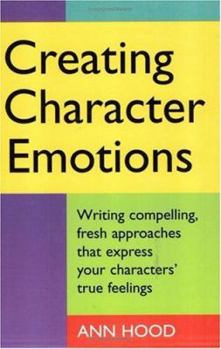Creating Character Emotions
In this unique book, Ann Hood will help you find fresh, creative images, words and gestures to evoke feelings in your fiction. In 36 "mini-lessons," Hood sheds new light on love, hate, fear, grief,... This description may be from another edition of this product.
Format:Paperback
Language:English
ISBN:1884910335
ISBN13:9781884910333
Release Date:January 1998
Publisher:Story Press Books
Length:176 Pages
Weight:0.65 lbs.
Dimensions:0.6" x 5.9" x 9.0"
Customer Reviews
5 ratings
The Complexity of the human condition.
Published by Thriftbooks.com User , 17 years ago
I'm disappointed in most of the other reviews of this book and the low rankings other readers gave it. Maybe they just don't get it. Maybe they have trouble seeing how complex we humans are. Most men, like myself, tend to be reluctant to show emotion in public. We tend to hide all but anger so we don't give away our weaknesses. I taught English grammar and literature for thirty years and although Ann Hood does not spend a lot of time on any one emotion, she manages to convey just how complex we humans are by quickly glossing over the thirty-six emotions she shows us in her book. I appreciate the way she organized her little book on creating character emotions. I wish I had read it soon after it came out in print. I would have added some of what she wrote into my lessons on characterization. Although I haven't read some of the other books out there about creating emotions, like the one by Orson Scott Card, which I plan to read next, I can not discount the fact that she has provided me with some valuable seeds for thought. As a teacher, I've learned that there are many ways to teach one thing and one method will not reach everyone. I have three books on this subject and Hood's is the first one I've read and I like her approach. I recommend this book to anyone who seriously wants to improve his or her writing and do not stop with just this one book. Read others so that you will really learn how to write. I'm also a writer. My wife has written national and international bestsellers. One book my wife wrote was a New York Times Notable Book of the Year. I've edited my wife's work, and nothing woke me to the complexity of developing the characters I write about in my stories like this book did. I hope the other books I will read after this one add more to my growing knowledge. Reading this book was like opening a door and walking into a well-lit room. I get it. I finally get it. Maybe I'm just dense and it took someone like Ann Hood to wake me up so I understand what emotion is all about.
Specific and helpful
Published by Thriftbooks.com User , 19 years ago
Imagine my surprise when I recognized my own writing mistakes in the examples of bad writing. This immediately helped me take my writing to the next level. I have many cherished writing books, and this one holds up well in comparison. It is helpful because it's specific and focused. I couldn't wait to get to the computer and apply the things I learned in this book. I'm happy to add it to my bookcase.
Great reference!
Published by Thriftbooks.com User , 19 years ago
A masterful piece of work! Beautifully organized. Short, to the point, brilliantly concise. The Good, the Bad, and the Ugly! Far more effective and memorable than the well-known Clint Eastwood movie. Without blurring the line in any way, Ann Hood tells it like it is. A return to apprenticeship is called for where needed, and a good ready-reference is provided where not. She makes clear that ignoring these extremes could spell a quick trip to oblivion, shorthand for which is the bluntness of her message. Red flags, whistles, and horns of warning abound. If you are about to launch a writing effort saturated with raw emotion, you'd better pay heed. ##### This mastersroke of precise problem depiction should be a much dog-eared addition to every writer's library.
Practical and extremely useful for begining writers
Published by Thriftbooks.com User , 20 years ago
This book should prove extremely useful for any writer who's just starting out or just beginning to send stuff out to publishers; Ms. Hood goes chapter by chapter through the entire gamut of primary human emotions, with bad examples (cliches, stereotypes,ineffective useage, overly expository, or emotionally dead language) and good exmaples following each. No matter how obvious the bad examples may or may not be (and I for one, aren't so sure that some beginning writers are reading the bad examples and thinking...hmmm, seems okay to me), I strongly recommend following the exercises; it's one thing to read a writing mechanics book like this, but put it into practiceis another task entirely.4 stars. A great book for my writing toolkit.
Prevent your characters from turning into cliches
Published by Thriftbooks.com User , 25 years ago
I would recommend this book to anyone who writes characters and wants to portray them as real people with emotions and reactions others can relate to. It really opened my eyes to the kind of cliched emotions many of us are caught up in while writing characters and how that really stiffles a story or novel's effectiveness. This book teaches you how to make your characters feel, and not just label them as 'sad' or 'happy' - that doesn't involve the reader. You learn how to describe your characters in such a way that the reader knows how they feel without you having to label the emotion.





